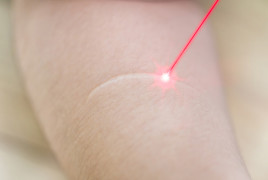Vitiligo: Who gets and causes
Who gets vitiligo?
Millions of people worldwide have vitiligo. Nearly half get it before they reach 21 years of age. Most will have vitiligo for the rest of their lives. It is very rare for vitiligo to disappear.
Vitiligo can affect your hair
The patch of white hair near this 22-year-old man's part is caused by vitiligo.

Vitiligo occurs about equally in people of all skin colors and races. About half the people who get vitiligo are male and half are female.
The risk of getting vitiligo increases if a person has:
A close blood relative who has vitiligo
An autoimmune disease, especially Hashimoto’s disease (a thyroid disease) or alopecia areata (causes hair loss)
What causes vitiligo?
Vitiligo develops when cells called melanocytes die. These cells give our skin and hair color.
Scientists do not completely understand why these cells die. One type of vitiligo, non-segmental vitiligo, may be an autoimmune disease. An autoimmune disease develops when the body mistakes a part of itself as foreign. If the body mistakes melanocytes as foreigners, it will attack and kill these cells.
Studies suggest that the other type of vitiligo, segmental vitiligo, has a different cause. This type seems to develop when something in the body’s nervous system goes awry.
Related AAD resources
Image
Image used with permission of the American Academy of Dermatology National Library of Dermatologic Teaching Slides.
References
Halder RM. “Vitiligo.” Forum presented at the 2011 American Academy of Dermatology Annual Meeting: New Orleans. February 2011.
Mazereeuw-Hautier J, Bezio S, Mahe E et al. Segmental and nonsegmental childhood vitiligo has distinct clinical characteristics: a prospective observational study. J Am Acad Dermatol. 2010; 62: 945-9.
 Think sun protection during Skin Cancer Awareness Month
Think sun protection during Skin Cancer Awareness Month
 How to care for your skin if you have lupus
How to care for your skin if you have lupus
 Practice Safe Sun
Practice Safe Sun
 Sunscreen FAQs
Sunscreen FAQs
 Fade dark spots
Fade dark spots
 Hidradenitis suppurativa
Hidradenitis suppurativa
 Laser hair removal
Laser hair removal
 Scar treatment
Scar treatment
 Botox
Botox
 Kids' camp - Camp Discovery
Kids' camp - Camp Discovery
 Dermatologist-approved lesson plans, activities you can use
Dermatologist-approved lesson plans, activities you can use
 Find a Dermatologist
Find a Dermatologist
 Why choose a board-certified dermatologist?
Why choose a board-certified dermatologist?